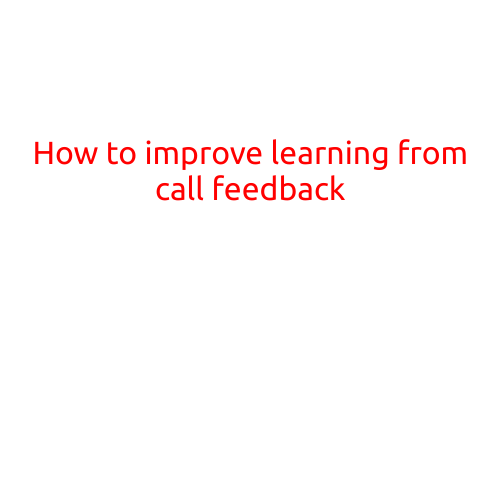
How to Improve Learning from Call Feedback
In the world of customer service, call feedback is a crucial aspect of continuous improvement. It provides valuable insights into customer behavior, preferences, and needs, helping businesses refine their approaches to better meet customer expectations. However, not all call feedback is created equal, and it’s essential to extract the most valuable information to drive meaningful change. In this article, we’ll explore how to improve learning from call feedback and transform it into actionable insights.
Why Call Feedback Matters
Timely and accurate call feedback is essential for customer service teams to:
- Identify pain points and areas for improvement
- Understand customer needs and preferences
- Refine product or service offerings
- Enhance customer satisfaction and loyalty
How to Improve Learning from Call Feedback
Ensure Integrity and Timeliness: Collect call feedback promptly, and ensure the data is accurate and unbiased. This enables teams to quickly identify trends and anomalies, and respond to customer concerns efficiently.
Expand the Scope: Move beyond basic metrics, such as customer satisfaction (CSI) scores, to gather more comprehensive feedback. Include questions about customers’ experiences, opinions, and suggestions to capture a richer understanding of their needs.
Analyze and Categorize: Use data analysis tools to categorize call feedback into themes, patterns, and trends. This helps identify common pain points, areas for improvement, and opportunities for growth.
Prioritize and Focus: With a deeper understanding of call feedback, prioritize the most critical issues and focus on addressing them first. This ensures that teams allocate resources effectively and make meaningful progress.
Involve the Team: Encourage call center agents to participate in the feedback process by providing them with access to customer feedback and involving them in the analysis and problem-solving process. This fosters a sense of ownership and encourages team members to take a proactive approach to improvement.
Use Technology to Your Advantage: Leverage tools like speech analytics, call recording, and customer relationship management (CRM) software to streamline the feedback collection and analysis process. These technologies can help identify patterns and trends, and automate tasks, freeing up agents to focus on high-value activities.
Recognize and Reward: Acknowledge and reward team members who actively contribute to the improvement process, making it a more engaging and enjoyable experience for everyone involved.
Draw Insights, Not Conclusions: Avoid jumping to conclusions based on limited data or anecdotal evidence. Instead, draw insights from comprehensive analysis and weighted averages to ensure that decisions are informed by a broader perspective.
Best Practices for Actionable Insights
Focus on the Customer: Always keep the customer at the forefront of improvement efforts. Use call feedback to identify and address their needs, concerns, and suggestions.
Quantify Feedback: Use metrics, such as CSI scores, to quantify feedback and track progress over time.
Monitor and Adjust: Regularly monitor the effectiveness of improvement initiatives and make adjustments as needed to ensure ongoing progress.
Document Processes: Clearly document processes and procedures to ensure that feedback-driven changes are implemented consistently and effectively.
Continuously Refine: Embrace an ongoing improvement mindset, refining processes and strategies to meet evolving customer needs and preferences.
By following these best practices, businesses can transform call feedback into actionable insights, driving meaningful improvements and exceptional customer experiences. By prioritizing timely, accurate, and comprehensive feedback collection and analysis, organizations can turn even the most mundane feedback into valuable learnings that drive growth, innovation, and Customer-Centricity.





